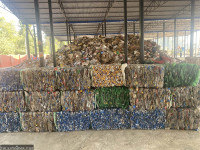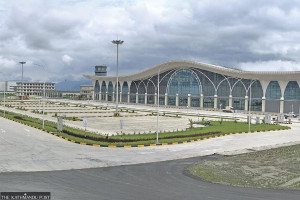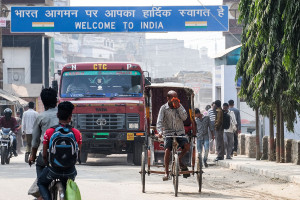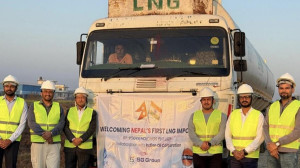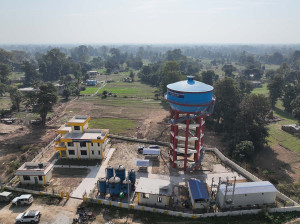Money
Remittances hit all-time high as Nepalis send home Rs4.72 billion daily
With over Rs1.7 trillion received last fiscal year, the figure rivals Nepal’s annual budget. But experts warn the money is piling up in banks instead of driving growth.
Krishana Prasain
Nepalis working abroad are sending home Rs4.72 billion every day, a financial lifeline that has sustained millions of households and kept the country’s economy afloat for decades.
In the last fiscal year, which ended in mid-July, Nepal received Rs1.72 trillion in remittances, a year-on-year growth of 19 percent, according to Nepal Rastra Bank’s recently released annual macroeconomic report. The figure is almost equal to the government’s yearly budget.
The report shows that remittance inflows have been hitting new records since the Covid pandemic. The highest monthly inflow reached Rs189.11 billion in the final month of the last fiscal year. Unlike previous spikes that came during festivals or after natural disasters, this rise was not tied to seasonal or emergency factors.
Behind the surge is a combination of factors: soaring outmigration, limited job opportunities at home, a stagnant economy, and the strengthening of the US dollar against the Nepali rupee.
According to the central bank, 505,957 Nepalis left the country for the first time for foreign employment last fiscal year, while 333,309 renewed their work permits, bringing the total to 839,266.
In the previous year, the total stood at 741,297.
This does not include the 119,409 students who went abroad in 2024, according to the Department of Immigration.
Labour experts say the market for Nepali workers is expanding, and many are shifting towards Western countries rather than traditional destinations in the Middle East, adding to the surge in remittances. The higher value of the dollar, euro, and pound has also significantly boosted the amount once converted into rupees.
“In fact, the dollar, euro and pound rates have increased in recent years, which become a large amount when converted into Nepali currency, boosting the remittance inflow,” said Jeevan Baniya, deputy director at Social Science Baha, an independent, non-profit research organisation.
He added that even students heading to countries such as the US, Australia, Japan, and South Korea are sending money back home. Recently, many Nepalis have also begun exploring European destinations where incomes are higher.
Another major shift since the pandemic has been the growing use of formal channels for money transfers.
Previously, a large share of remittances was sent through hundi, an informal system, which is also illegal.
But as countries like the United Arab Emirates and Saudi Arabia tightened anti-money laundering regulations, migrants increasingly turned to legal transfer agencies. The wider presence of licensed remittance companies in areas with large Nepali populations has made the shift easier.
“For example, sending money through hundi from South Korea or Gulf countries was common before the Covid pandemic, but now it has largely shifted to formal channels,” Baniya said.
This trend is expected to continue as outmigration for both work and study shows no signs of slowing down. Migration destinations are also changing. Nepalis are avoiding Malaysia due to reduced labour demand, while ongoing conflicts in the Middle East, including Israel, have pushed workers to look elsewhere.
At the same time, higher minimum wages in some countries have further boosted migrant incomes.
According to the ILO Global Wage Report, more countries than usual adjusted their minimum wage levels in 2022 and 2023, mainly in response to rising inflation. However, in most cases, the revisions were insufficient to offset the surge in the cost of living fully.
Data from 160 countries show that nearly 60 percent raised their minimum wages in 2022, but only one in four of those adjustments translated into an actual increase in real wages. In 2023, about 55 percent of countries saw minimum wages rise in real terms, yet in most cases, the increases were too small to recover the losses workers had suffered over the previous two years.
Despite the huge inflow, the bulk of remittances is used for household consumption, with only a small share going into savings or business investment. Families use the money mainly for education, health care, and daily expenses, which provides social upliftment but contributes little to long-term economic growth.
Nepal’s dependence on remittance has grown so deeply that it has effectively become a major labour-exporting nation, with rural households in particular depending on at least one member’s earnings from abroad. The failure of agriculture and other sectors to generate jobs has left foreign employment the only viable option for many.
Yet insiders warn of a systemic problem. The massive remittance inflow has piled up in banks, but low investment and weak consumption show that the economy remains sluggish.
Prakash Kumar Shrestha, a member of the National Planning Commission, said remittances will likely keep rising this fiscal year too. “However, bank interest rates are declining, which will encourage people to spend more on goods and possibly even invest,” he said.
Still, political uncertainty, rampant corruption, and poor accountability continue to strangle the country’s economic development. Youth, both skilled and unskilled, are leaving in droves, frustrated by the lack of opportunity at home.
Nepal’s economic growth was estimated at 4.61 percent in the last fiscal year, up slightly from 3.67 percent the previous year. Experts warn that such growth is too slow to create jobs, meaning outmigration will likely rise further.




 8.12°C Kathmandu
8.12°C Kathmandu



